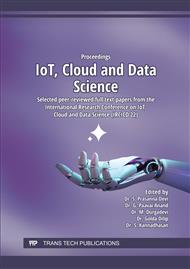[1]
Z. Cao, G. Hidalgo, T. S.-S. E. W. and Sheikh, Y. (2021). Openpose: Realtime multi-person 2d pose estimation using part affinity fields., IEEE Transactions on Pattern Analysis and Machine Intelligence.
DOI: 10.1109/tpami.2019.2929257
Google Scholar
[2]
Go, R. and Aoki, Y. (2016). Flexible top-view human pose estimation for detection system via cnn., IEEE 5th Global Conference on Consumer Electronics.
DOI: 10.1109/gcce.2016.7800406
Google Scholar
[3]
George Papandreou, Tyler Zhu, L.-C. C. S. G. J. T. K. M. (2018). Personlab: Person pose estimation and instance segmentation with a bottom-up, part-based, geometric embedding model." 15th European Conference on Computer Vision (ECCV), AITS.[4] et. al., T. L. M. "The progress of human pose estimation: A survey and taxonomy of models applied in 2d human pose estimation., IEEE Access, vol. 8.
DOI: 10.1007/978-3-030-01264-9_17
Google Scholar
[5]
Alexander Toshev, C. S. (2014). Deeppose: Human pose estimation via deep neural networks., IEEE Conference on Computer Vision and Pattern Recognition (CVPR).
DOI: 10.1109/cvpr.2014.214
Google Scholar
[6]
Kaiming He, Xiangyu Zhang, S. R.-J. S. (2016). Deep residual learning for image recognition., IEEE Conference on Computer Vision and Pattern Recognition (CVPR).
DOI: 10.1109/cvpr.2016.90
Google Scholar
[7]
Simonyan, K. and Zisserman, A. (2015). Very deep convolutional networks for large-scale image recognition., 3rd International Conference on Learning Representations (ICLR).
Google Scholar
[8]
S. Wei, V. Ramakrishna, T. K. and Sheikh, Y. (2016). Convolutional pose machines., IEEE Conference on Computer Vision and Pattern Recognition (CVPR).
DOI: 10.1109/cvpr.2016.511
Google Scholar
[9]
Hao-Shu Fang, Shuqin Xie, Y.-W. T. C. L. (2017). Rmpe: Regional multi-person pose estimation., IEEE International Conference on Computer Vision (ICCV).
DOI: 10.1109/iccv.2017.256
Google Scholar
[10]
Bin Xiao, H. W. and Wei, Y. (2018). Simple baselines for human pose estimation and tracking., 15th European Conference on Computer Vision (ECCV).
DOI: 10.1007/978-3-030-01231-1_29
Google Scholar
[11]
Baoshi Cao, Kui Sun, M. J.-C. H. Y. Z. H. L. (2016). Design and development of a two-dof torso for humanoid robot., International Conference on Advanced Intelligent Mechatronics (AIM).
DOI: 10.1109/aim.2016.7576741
Google Scholar
[12]
Z. Huang, F. L. and Xu, L. (2020). Modeling and simulation of 6 dof robotic arm based on gazebo., 6th International Conference on Control, Automation and Robotics (ICCAR).
DOI: 10.1109/iccar49639.2020.9107989
Google Scholar
[13]
Dafni Antotsiou, Guillermo Garcia-Hernando, and Tae-Kyun Kim (2018). Task-oriented hand motion retargeting for dexterous manipulation imitation., European Conference on Computer Vision (ECCV).
DOI: 10.1007/978-3-030-11024-6_19
Google Scholar
[14]
Aude G Billard, Sylvain Calinon, and Florent Guenter (2006). Discriminative and adaptive imitation in uni-manual and bi-manual tasks., Robotics and Autonomous Systems, 54 (5):370-384.
DOI: 10.1016/j.robot.2006.01.007
Google Scholar
[15]
Ankur Handa, Karl Van Wyk, Wei Yang, Jacky Liang, Yu-Wei Chao, Qian Wan, Stan Birchfield, Nathan Ratliff, and Dieter Fox (2020). Dexpilot: Vision-based teleoperation of dexterous robotic hand-arm system., IEEE International Conference on Robotics and Automation (ICRA), pages 9164-917.
DOI: 10.1109/icra40945.2020.9197124
Google Scholar
[16]
Shuang Li, Xiaojian Ma, Hongzhuo Liang, Michael Gorner, Philipp Ruppel, Bin Fang, Fuchun Sun, and Jianwei Zhang (2019). Vision-based teleoperation of shadow dexterous hand using end-to-end deep neural network., International Conference on Robotics and Automation (ICRA), pages 416-422.
DOI: 10.1109/icra.2019.8794277
Google Scholar


